Civil Engineering Technology: Earthwork, Hazards, Design Report
VerifiedAdded on 2023/01/19
|17
|3009
|92
Report
AI Summary
This report details various aspects of civil engineering, beginning with earthwork processes including excavation, transportation, and compaction, along with the equipment and techniques employed. It then explores foundation methods, drainage work, and culvert construction. The report addresses hazards and risks in confined spaces and on tall structures, providing a method statement for site installation and a comprehensive safety plan, including a risk assessment form. Furthermore, it examines the environmental, quality, geotechnical, and economic contexts of a civil engineering problem, specifically the impact of an industrial complex near a river. Finally, the report outlines methods and techniques used in highway design, considering factors such as road type, traffic volume, and budgetary constraints. The report also covers health and safety legislation and codes of practice relevant to civil engineering sites.
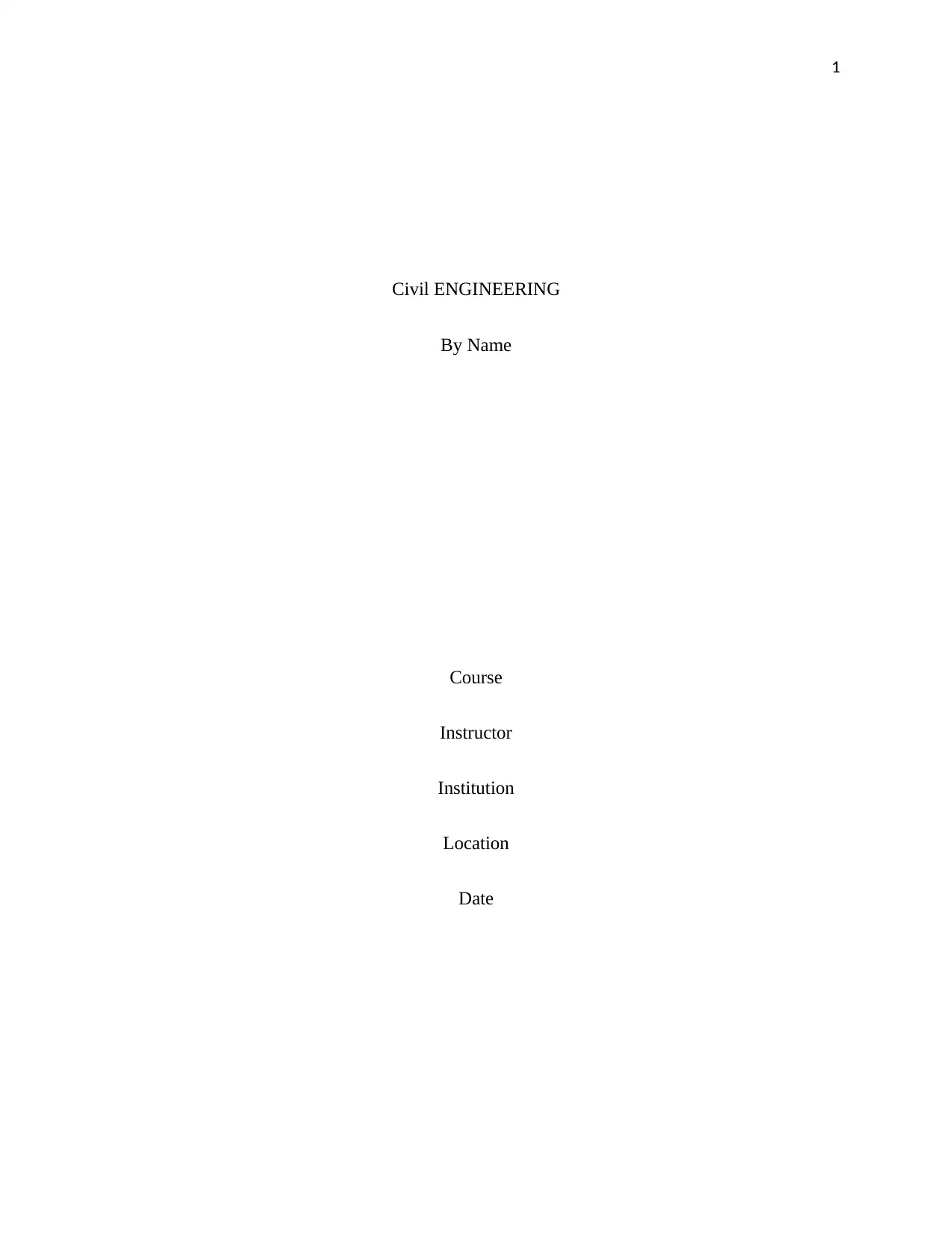
1
Civil ENGINEERING
By Name
Course
Instructor
Institution
Location
Date
Civil ENGINEERING
By Name
Course
Instructor
Institution
Location
Date
Paraphrase This Document
Need a fresh take? Get an instant paraphrase of this document with our AI Paraphraser
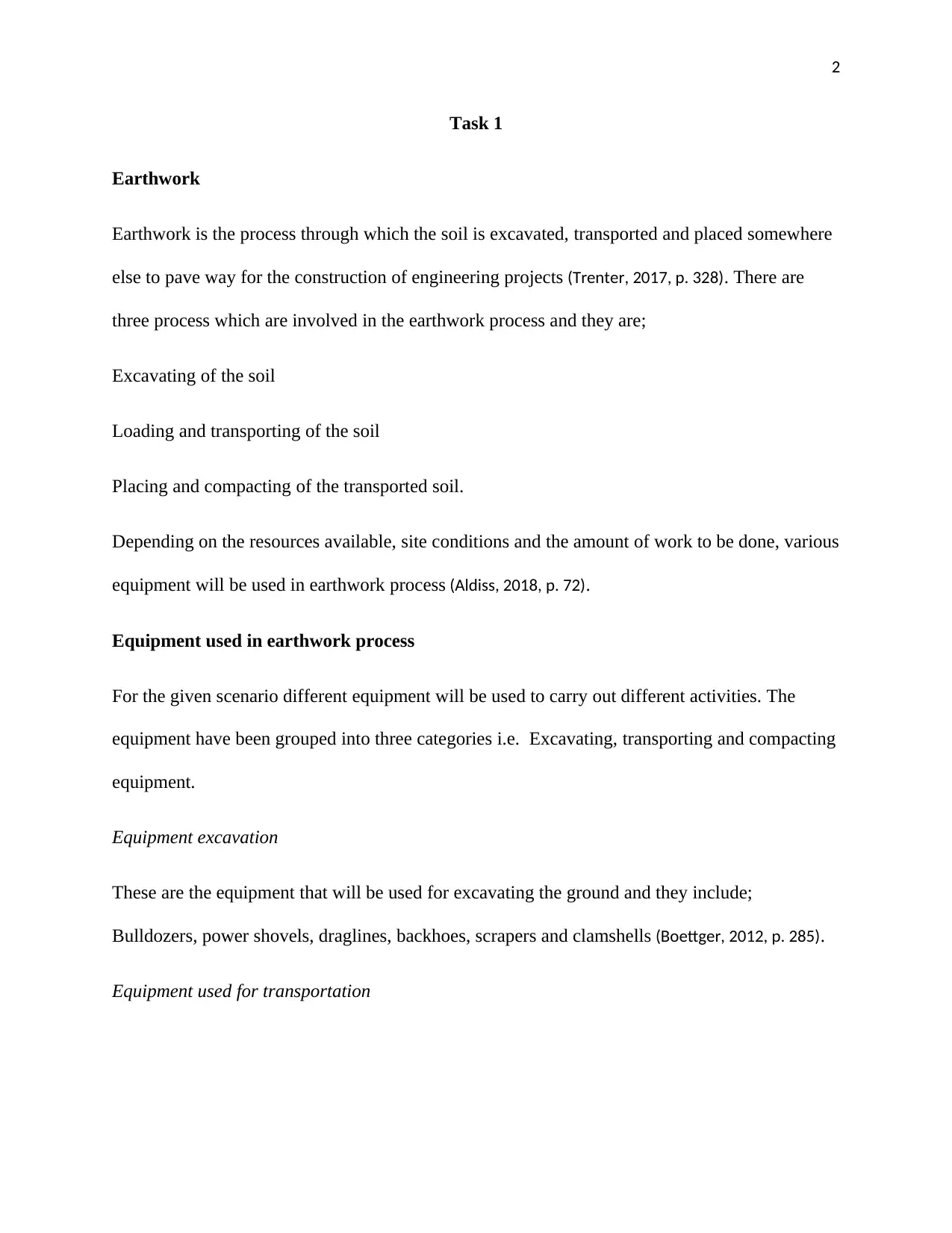
2
Task 1
Earthwork
Earthwork is the process through which the soil is excavated, transported and placed somewhere
else to pave way for the construction of engineering projects (Trenter, 2017, p. 328). There are
three process which are involved in the earthwork process and they are;
Excavating of the soil
Loading and transporting of the soil
Placing and compacting of the transported soil.
Depending on the resources available, site conditions and the amount of work to be done, various
equipment will be used in earthwork process (Aldiss, 2018, p. 72).
Equipment used in earthwork process
For the given scenario different equipment will be used to carry out different activities. The
equipment have been grouped into three categories i.e. Excavating, transporting and compacting
equipment.
Equipment excavation
These are the equipment that will be used for excavating the ground and they include;
Bulldozers, power shovels, draglines, backhoes, scrapers and clamshells (Boettger, 2012, p. 285).
Equipment used for transportation
Task 1
Earthwork
Earthwork is the process through which the soil is excavated, transported and placed somewhere
else to pave way for the construction of engineering projects (Trenter, 2017, p. 328). There are
three process which are involved in the earthwork process and they are;
Excavating of the soil
Loading and transporting of the soil
Placing and compacting of the transported soil.
Depending on the resources available, site conditions and the amount of work to be done, various
equipment will be used in earthwork process (Aldiss, 2018, p. 72).
Equipment used in earthwork process
For the given scenario different equipment will be used to carry out different activities. The
equipment have been grouped into three categories i.e. Excavating, transporting and compacting
equipment.
Equipment excavation
These are the equipment that will be used for excavating the ground and they include;
Bulldozers, power shovels, draglines, backhoes, scrapers and clamshells (Boettger, 2012, p. 285).
Equipment used for transportation
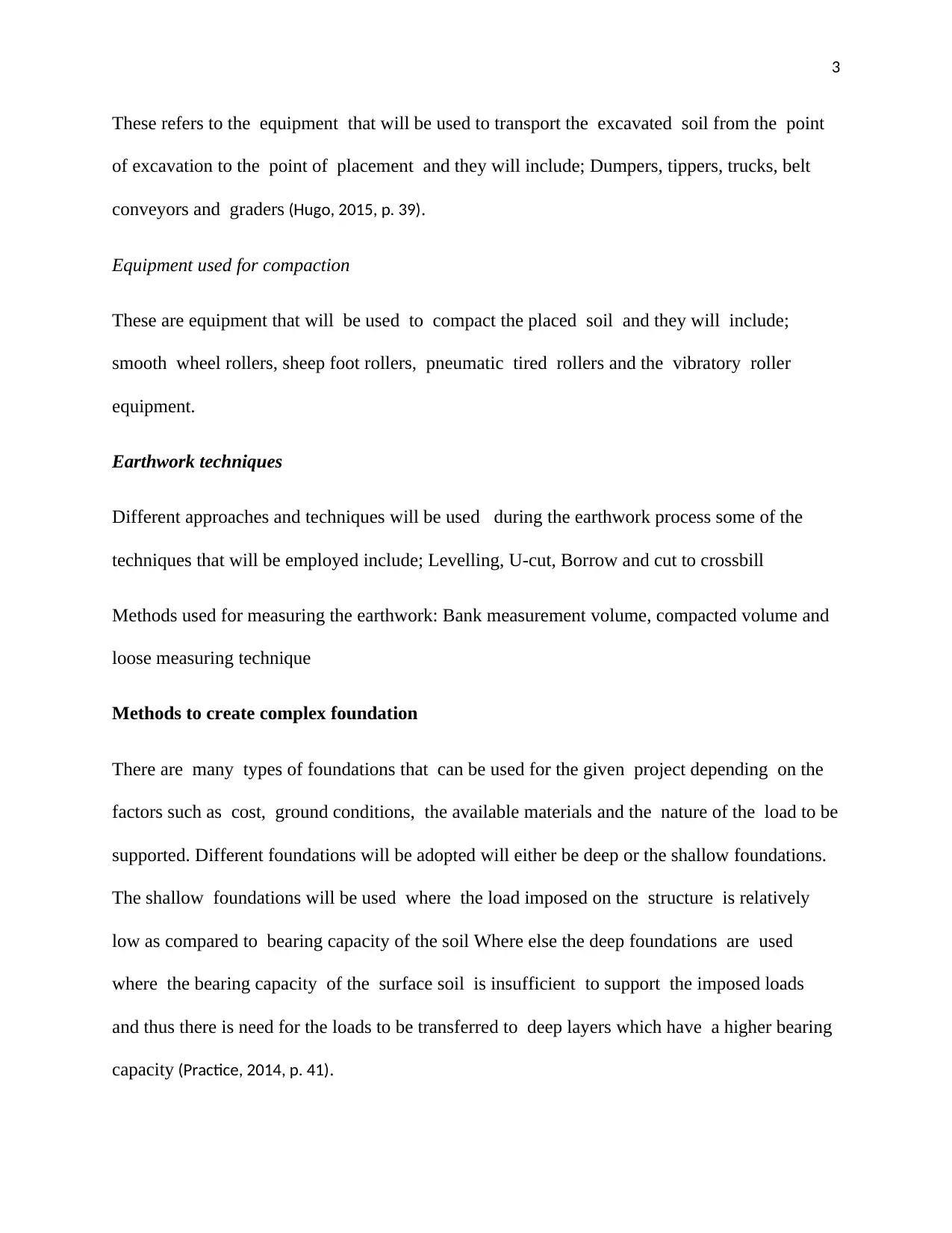
3
These refers to the equipment that will be used to transport the excavated soil from the point
of excavation to the point of placement and they will include; Dumpers, tippers, trucks, belt
conveyors and graders (Hugo, 2015, p. 39).
Equipment used for compaction
These are equipment that will be used to compact the placed soil and they will include;
smooth wheel rollers, sheep foot rollers, pneumatic tired rollers and the vibratory roller
equipment.
Earthwork techniques
Different approaches and techniques will be used during the earthwork process some of the
techniques that will be employed include; Levelling, U-cut, Borrow and cut to crossbill
Methods used for measuring the earthwork: Bank measurement volume, compacted volume and
loose measuring technique
Methods to create complex foundation
There are many types of foundations that can be used for the given project depending on the
factors such as cost, ground conditions, the available materials and the nature of the load to be
supported. Different foundations will be adopted will either be deep or the shallow foundations.
The shallow foundations will be used where the load imposed on the structure is relatively
low as compared to bearing capacity of the soil Where else the deep foundations are used
where the bearing capacity of the surface soil is insufficient to support the imposed loads
and thus there is need for the loads to be transferred to deep layers which have a higher bearing
capacity (Practice, 2014, p. 41).
These refers to the equipment that will be used to transport the excavated soil from the point
of excavation to the point of placement and they will include; Dumpers, tippers, trucks, belt
conveyors and graders (Hugo, 2015, p. 39).
Equipment used for compaction
These are equipment that will be used to compact the placed soil and they will include;
smooth wheel rollers, sheep foot rollers, pneumatic tired rollers and the vibratory roller
equipment.
Earthwork techniques
Different approaches and techniques will be used during the earthwork process some of the
techniques that will be employed include; Levelling, U-cut, Borrow and cut to crossbill
Methods used for measuring the earthwork: Bank measurement volume, compacted volume and
loose measuring technique
Methods to create complex foundation
There are many types of foundations that can be used for the given project depending on the
factors such as cost, ground conditions, the available materials and the nature of the load to be
supported. Different foundations will be adopted will either be deep or the shallow foundations.
The shallow foundations will be used where the load imposed on the structure is relatively
low as compared to bearing capacity of the soil Where else the deep foundations are used
where the bearing capacity of the surface soil is insufficient to support the imposed loads
and thus there is need for the loads to be transferred to deep layers which have a higher bearing
capacity (Practice, 2014, p. 41).
⊘ This is a preview!⊘
Do you want full access?
Subscribe today to unlock all pages.

Trusted by 1+ million students worldwide
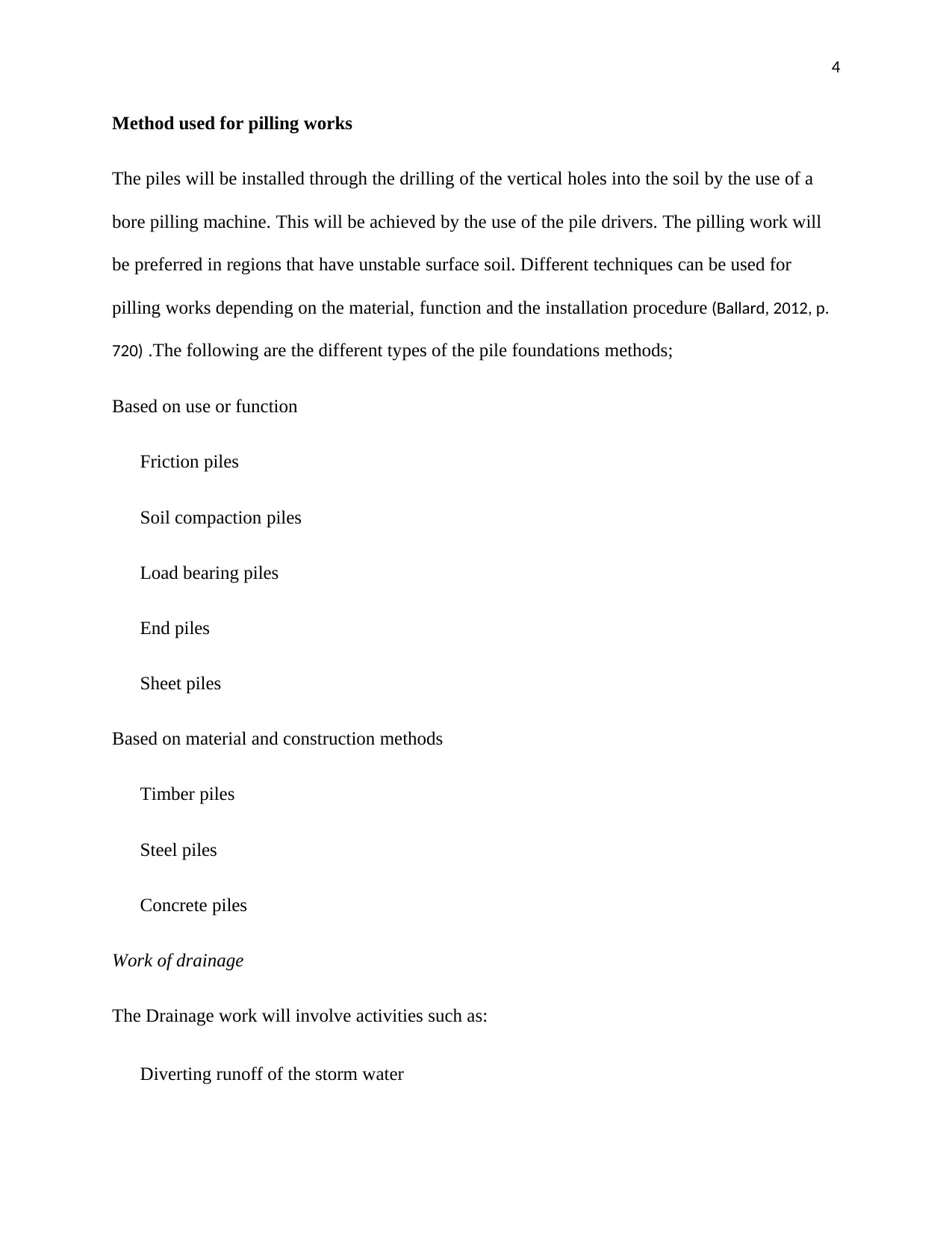
4
Method used for pilling works
The piles will be installed through the drilling of the vertical holes into the soil by the use of a
bore pilling machine. This will be achieved by the use of the pile drivers. The pilling work will
be preferred in regions that have unstable surface soil. Different techniques can be used for
pilling works depending on the material, function and the installation procedure (Ballard, 2012, p.
720) .The following are the different types of the pile foundations methods;
Based on use or function
Friction piles
Soil compaction piles
Load bearing piles
End piles
Sheet piles
Based on material and construction methods
Timber piles
Steel piles
Concrete piles
Work of drainage
The Drainage work will involve activities such as:
Diverting runoff of the storm water
Method used for pilling works
The piles will be installed through the drilling of the vertical holes into the soil by the use of a
bore pilling machine. This will be achieved by the use of the pile drivers. The pilling work will
be preferred in regions that have unstable surface soil. Different techniques can be used for
pilling works depending on the material, function and the installation procedure (Ballard, 2012, p.
720) .The following are the different types of the pile foundations methods;
Based on use or function
Friction piles
Soil compaction piles
Load bearing piles
End piles
Sheet piles
Based on material and construction methods
Timber piles
Steel piles
Concrete piles
Work of drainage
The Drainage work will involve activities such as:
Diverting runoff of the storm water
Paraphrase This Document
Need a fresh take? Get an instant paraphrase of this document with our AI Paraphraser
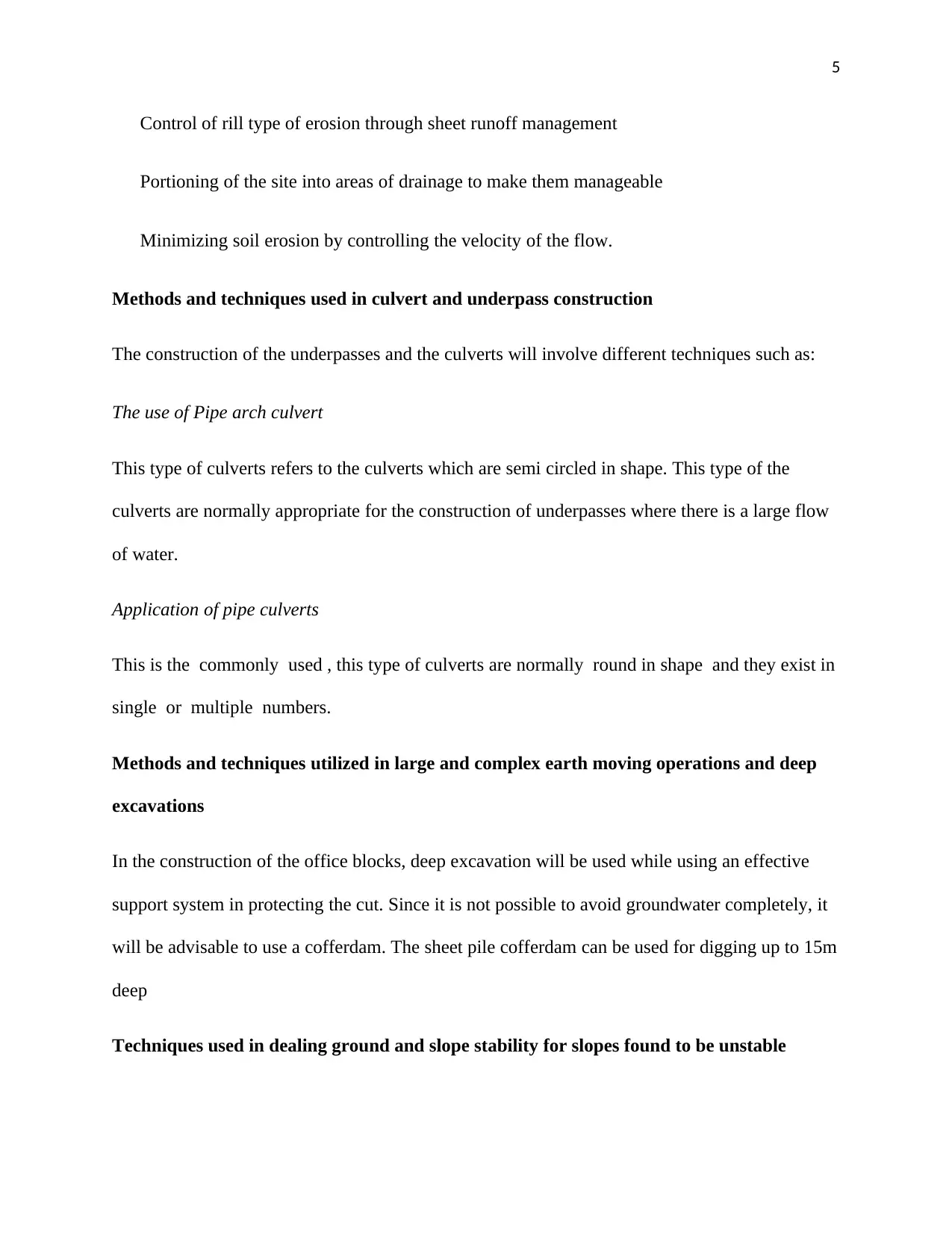
5
Control of rill type of erosion through sheet runoff management
Portioning of the site into areas of drainage to make them manageable
Minimizing soil erosion by controlling the velocity of the flow.
Methods and techniques used in culvert and underpass construction
The construction of the underpasses and the culverts will involve different techniques such as:
The use of Pipe arch culvert
This type of culverts refers to the culverts which are semi circled in shape. This type of the
culverts are normally appropriate for the construction of underpasses where there is a large flow
of water.
Application of pipe culverts
This is the commonly used , this type of culverts are normally round in shape and they exist in
single or multiple numbers.
Methods and techniques utilized in large and complex earth moving operations and deep
excavations
In the construction of the office blocks, deep excavation will be used while using an effective
support system in protecting the cut. Since it is not possible to avoid groundwater completely, it
will be advisable to use a cofferdam. The sheet pile cofferdam can be used for digging up to 15m
deep
Techniques used in dealing ground and slope stability for slopes found to be unstable
Control of rill type of erosion through sheet runoff management
Portioning of the site into areas of drainage to make them manageable
Minimizing soil erosion by controlling the velocity of the flow.
Methods and techniques used in culvert and underpass construction
The construction of the underpasses and the culverts will involve different techniques such as:
The use of Pipe arch culvert
This type of culverts refers to the culverts which are semi circled in shape. This type of the
culverts are normally appropriate for the construction of underpasses where there is a large flow
of water.
Application of pipe culverts
This is the commonly used , this type of culverts are normally round in shape and they exist in
single or multiple numbers.
Methods and techniques utilized in large and complex earth moving operations and deep
excavations
In the construction of the office blocks, deep excavation will be used while using an effective
support system in protecting the cut. Since it is not possible to avoid groundwater completely, it
will be advisable to use a cofferdam. The sheet pile cofferdam can be used for digging up to 15m
deep
Techniques used in dealing ground and slope stability for slopes found to be unstable
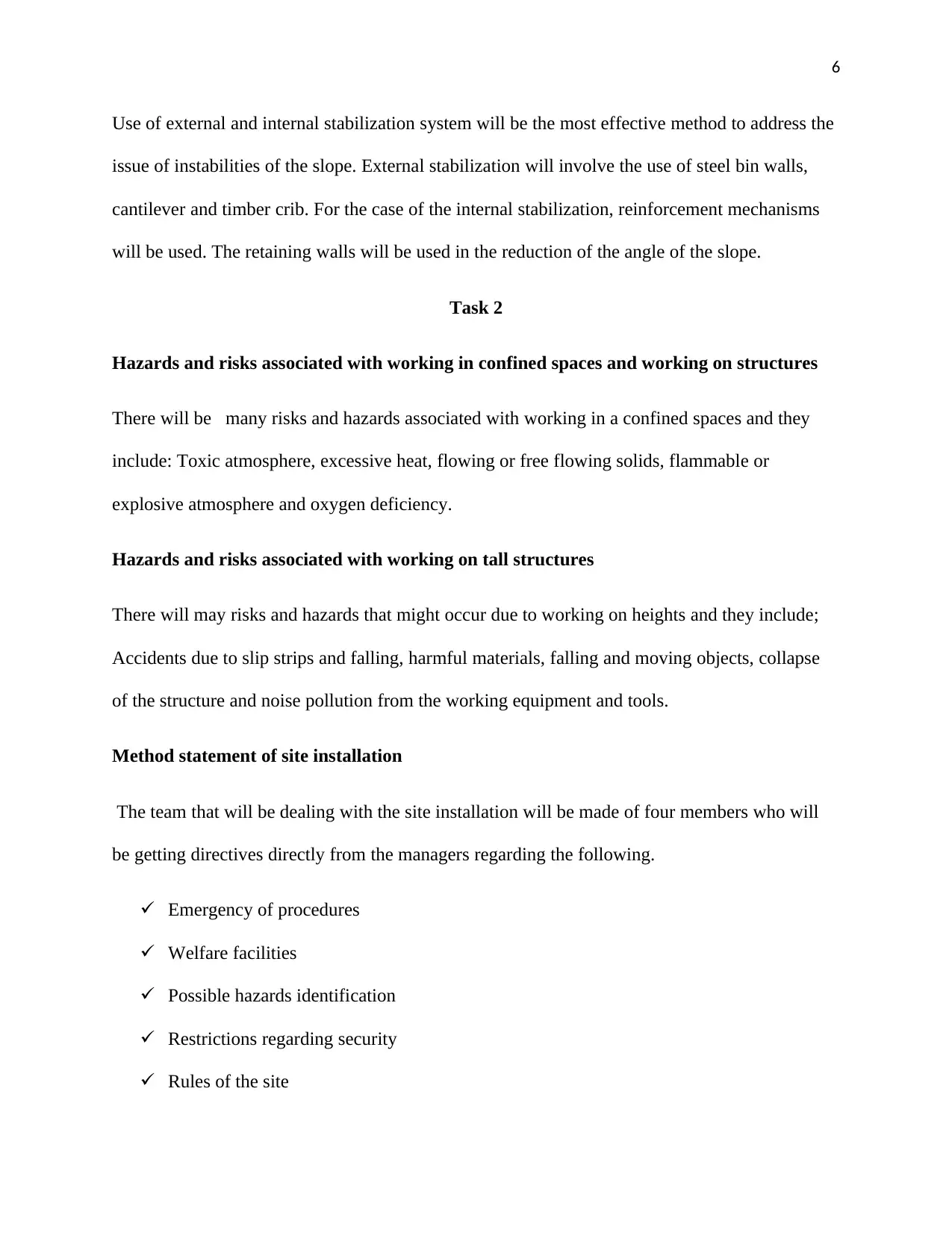
6
Use of external and internal stabilization system will be the most effective method to address the
issue of instabilities of the slope. External stabilization will involve the use of steel bin walls,
cantilever and timber crib. For the case of the internal stabilization, reinforcement mechanisms
will be used. The retaining walls will be used in the reduction of the angle of the slope.
Task 2
Hazards and risks associated with working in confined spaces and working on structures
There will be many risks and hazards associated with working in a confined spaces and they
include: Toxic atmosphere, excessive heat, flowing or free flowing solids, flammable or
explosive atmosphere and oxygen deficiency.
Hazards and risks associated with working on tall structures
There will may risks and hazards that might occur due to working on heights and they include;
Accidents due to slip strips and falling, harmful materials, falling and moving objects, collapse
of the structure and noise pollution from the working equipment and tools.
Method statement of site installation
The team that will be dealing with the site installation will be made of four members who will
be getting directives directly from the managers regarding the following.
Emergency of procedures
Welfare facilities
Possible hazards identification
Restrictions regarding security
Rules of the site
Use of external and internal stabilization system will be the most effective method to address the
issue of instabilities of the slope. External stabilization will involve the use of steel bin walls,
cantilever and timber crib. For the case of the internal stabilization, reinforcement mechanisms
will be used. The retaining walls will be used in the reduction of the angle of the slope.
Task 2
Hazards and risks associated with working in confined spaces and working on structures
There will be many risks and hazards associated with working in a confined spaces and they
include: Toxic atmosphere, excessive heat, flowing or free flowing solids, flammable or
explosive atmosphere and oxygen deficiency.
Hazards and risks associated with working on tall structures
There will may risks and hazards that might occur due to working on heights and they include;
Accidents due to slip strips and falling, harmful materials, falling and moving objects, collapse
of the structure and noise pollution from the working equipment and tools.
Method statement of site installation
The team that will be dealing with the site installation will be made of four members who will
be getting directives directly from the managers regarding the following.
Emergency of procedures
Welfare facilities
Possible hazards identification
Restrictions regarding security
Rules of the site
⊘ This is a preview!⊘
Do you want full access?
Subscribe today to unlock all pages.

Trusted by 1+ million students worldwide
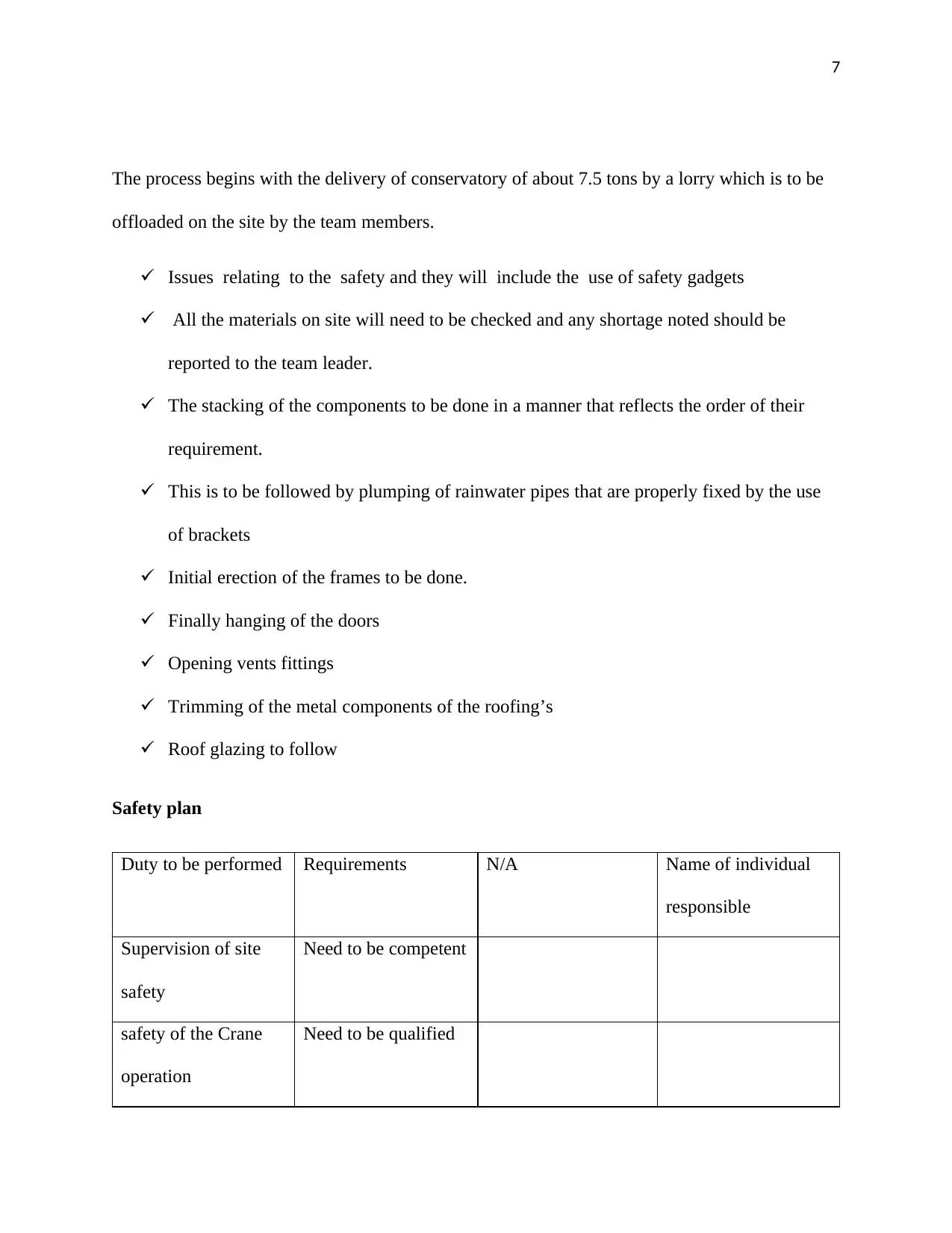
7
The process begins with the delivery of conservatory of about 7.5 tons by a lorry which is to be
offloaded on the site by the team members.
Issues relating to the safety and they will include the use of safety gadgets
All the materials on site will need to be checked and any shortage noted should be
reported to the team leader.
The stacking of the components to be done in a manner that reflects the order of their
requirement.
This is to be followed by plumping of rainwater pipes that are properly fixed by the use
of brackets
Initial erection of the frames to be done.
Finally hanging of the doors
Opening vents fittings
Trimming of the metal components of the roofing’s
Roof glazing to follow
Safety plan
Duty to be performed Requirements N/A Name of individual
responsible
Supervision of site
safety
Need to be competent
safety of the Crane
operation
Need to be qualified
The process begins with the delivery of conservatory of about 7.5 tons by a lorry which is to be
offloaded on the site by the team members.
Issues relating to the safety and they will include the use of safety gadgets
All the materials on site will need to be checked and any shortage noted should be
reported to the team leader.
The stacking of the components to be done in a manner that reflects the order of their
requirement.
This is to be followed by plumping of rainwater pipes that are properly fixed by the use
of brackets
Initial erection of the frames to be done.
Finally hanging of the doors
Opening vents fittings
Trimming of the metal components of the roofing’s
Roof glazing to follow
Safety plan
Duty to be performed Requirements N/A Name of individual
responsible
Supervision of site
safety
Need to be competent
safety of the Crane
operation
Need to be qualified
Paraphrase This Document
Need a fresh take? Get an instant paraphrase of this document with our AI Paraphraser
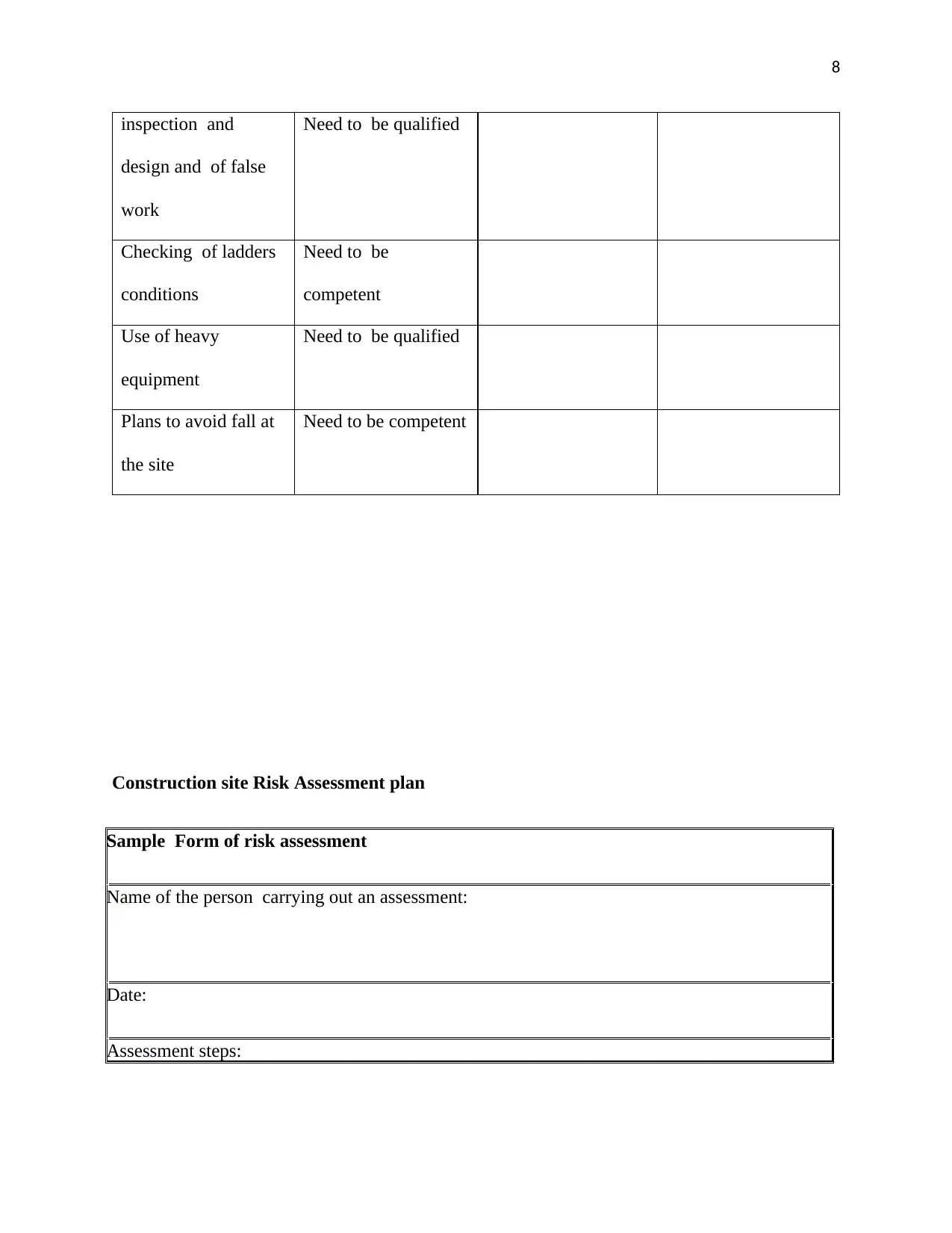
8
inspection and
design and of false
work
Need to be qualified
Checking of ladders
conditions
Need to be
competent
Use of heavy
equipment
Need to be qualified
Plans to avoid fall at
the site
Need to be competent
Construction site Risk Assessment plan
Sample Form of risk assessment
Name of the person carrying out an assessment:
Date:
Assessment steps:
inspection and
design and of false
work
Need to be qualified
Checking of ladders
conditions
Need to be
competent
Use of heavy
equipment
Need to be qualified
Plans to avoid fall at
the site
Need to be competent
Construction site Risk Assessment plan
Sample Form of risk assessment
Name of the person carrying out an assessment:
Date:
Assessment steps:
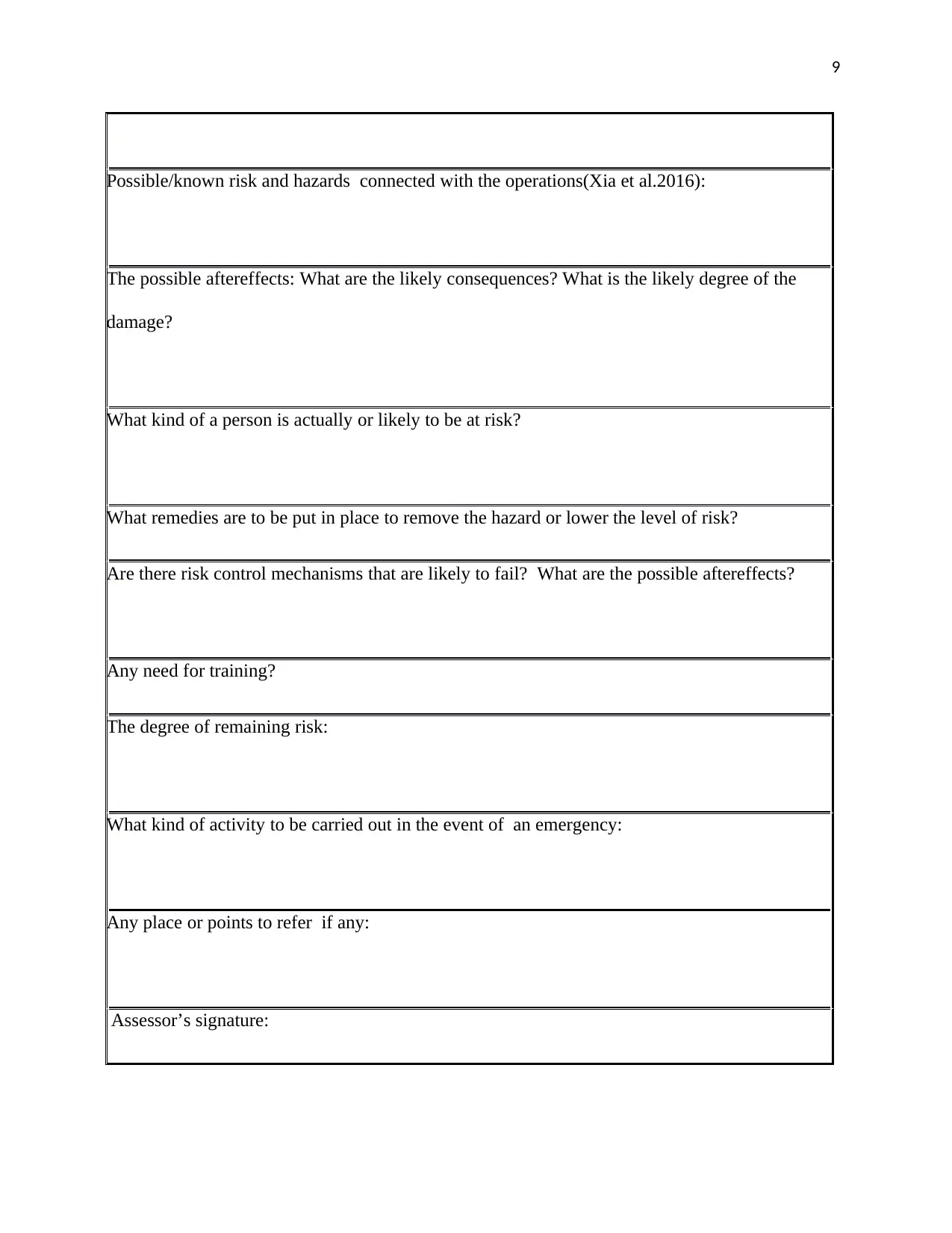
9
Possible/known risk and hazards connected with the operations(Xia et al.2016):
The possible aftereffects: What are the likely consequences? What is the likely degree of the
damage?
What kind of a person is actually or likely to be at risk?
What remedies are to be put in place to remove the hazard or lower the level of risk?
Are there risk control mechanisms that are likely to fail? What are the possible aftereffects?
Any need for training?
The degree of remaining risk:
What kind of activity to be carried out in the event of an emergency:
Any place or points to refer if any:
Assessor’s signature:
Possible/known risk and hazards connected with the operations(Xia et al.2016):
The possible aftereffects: What are the likely consequences? What is the likely degree of the
damage?
What kind of a person is actually or likely to be at risk?
What remedies are to be put in place to remove the hazard or lower the level of risk?
Are there risk control mechanisms that are likely to fail? What are the possible aftereffects?
Any need for training?
The degree of remaining risk:
What kind of activity to be carried out in the event of an emergency:
Any place or points to refer if any:
Assessor’s signature:
⊘ This is a preview!⊘
Do you want full access?
Subscribe today to unlock all pages.

Trusted by 1+ million students worldwide
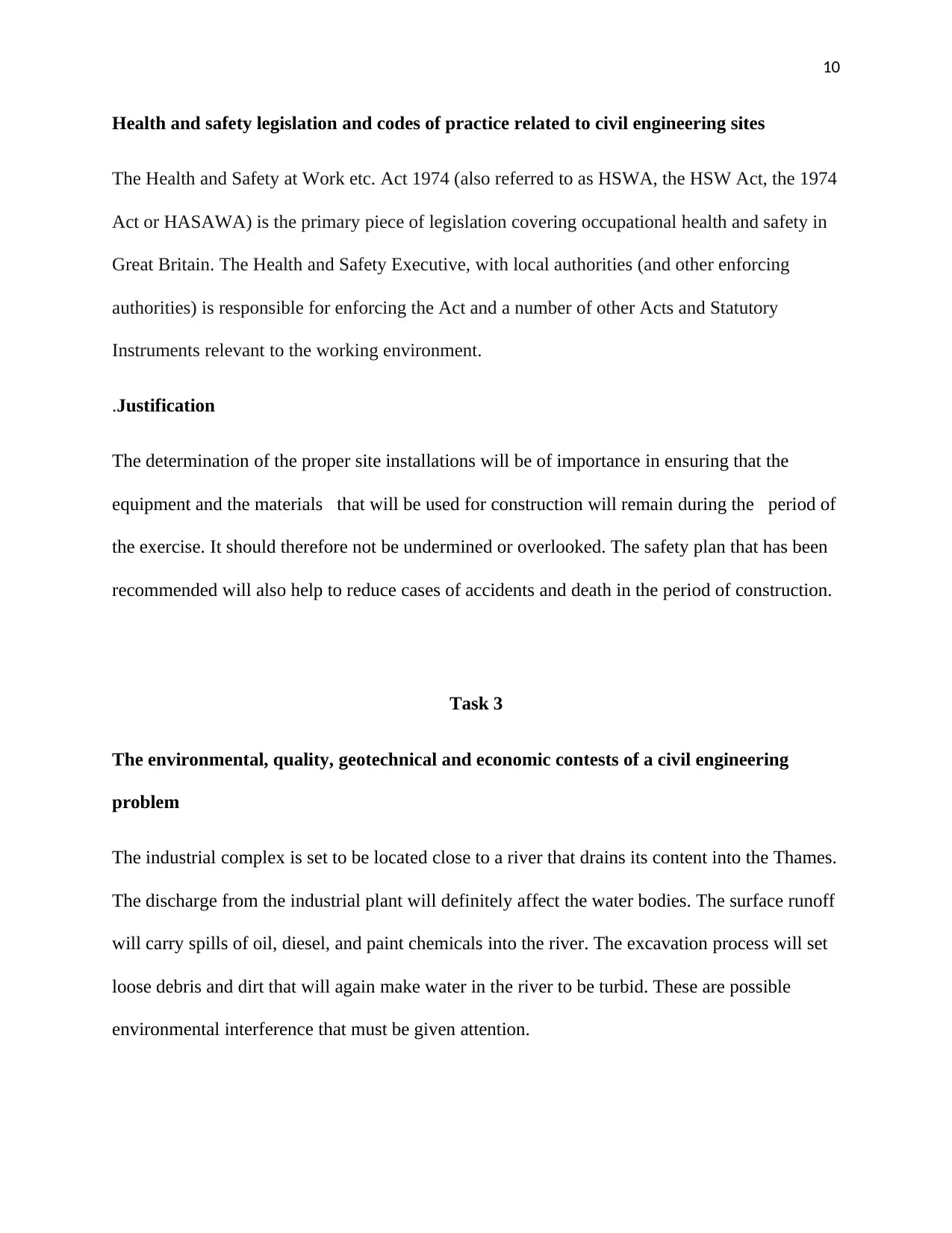
10
Health and safety legislation and codes of practice related to civil engineering sites
The Health and Safety at Work etc. Act 1974 (also referred to as HSWA, the HSW Act, the 1974
Act or HASAWA) is the primary piece of legislation covering occupational health and safety in
Great Britain. The Health and Safety Executive, with local authorities (and other enforcing
authorities) is responsible for enforcing the Act and a number of other Acts and Statutory
Instruments relevant to the working environment.
.Justification
The determination of the proper site installations will be of importance in ensuring that the
equipment and the materials that will be used for construction will remain during the period of
the exercise. It should therefore not be undermined or overlooked. The safety plan that has been
recommended will also help to reduce cases of accidents and death in the period of construction.
Task 3
The environmental, quality, geotechnical and economic contests of a civil engineering
problem
The industrial complex is set to be located close to a river that drains its content into the Thames.
The discharge from the industrial plant will definitely affect the water bodies. The surface runoff
will carry spills of oil, diesel, and paint chemicals into the river. The excavation process will set
loose debris and dirt that will again make water in the river to be turbid. These are possible
environmental interference that must be given attention.
Health and safety legislation and codes of practice related to civil engineering sites
The Health and Safety at Work etc. Act 1974 (also referred to as HSWA, the HSW Act, the 1974
Act or HASAWA) is the primary piece of legislation covering occupational health and safety in
Great Britain. The Health and Safety Executive, with local authorities (and other enforcing
authorities) is responsible for enforcing the Act and a number of other Acts and Statutory
Instruments relevant to the working environment.
.Justification
The determination of the proper site installations will be of importance in ensuring that the
equipment and the materials that will be used for construction will remain during the period of
the exercise. It should therefore not be undermined or overlooked. The safety plan that has been
recommended will also help to reduce cases of accidents and death in the period of construction.
Task 3
The environmental, quality, geotechnical and economic contests of a civil engineering
problem
The industrial complex is set to be located close to a river that drains its content into the Thames.
The discharge from the industrial plant will definitely affect the water bodies. The surface runoff
will carry spills of oil, diesel, and paint chemicals into the river. The excavation process will set
loose debris and dirt that will again make water in the river to be turbid. These are possible
environmental interference that must be given attention.
Paraphrase This Document
Need a fresh take? Get an instant paraphrase of this document with our AI Paraphraser
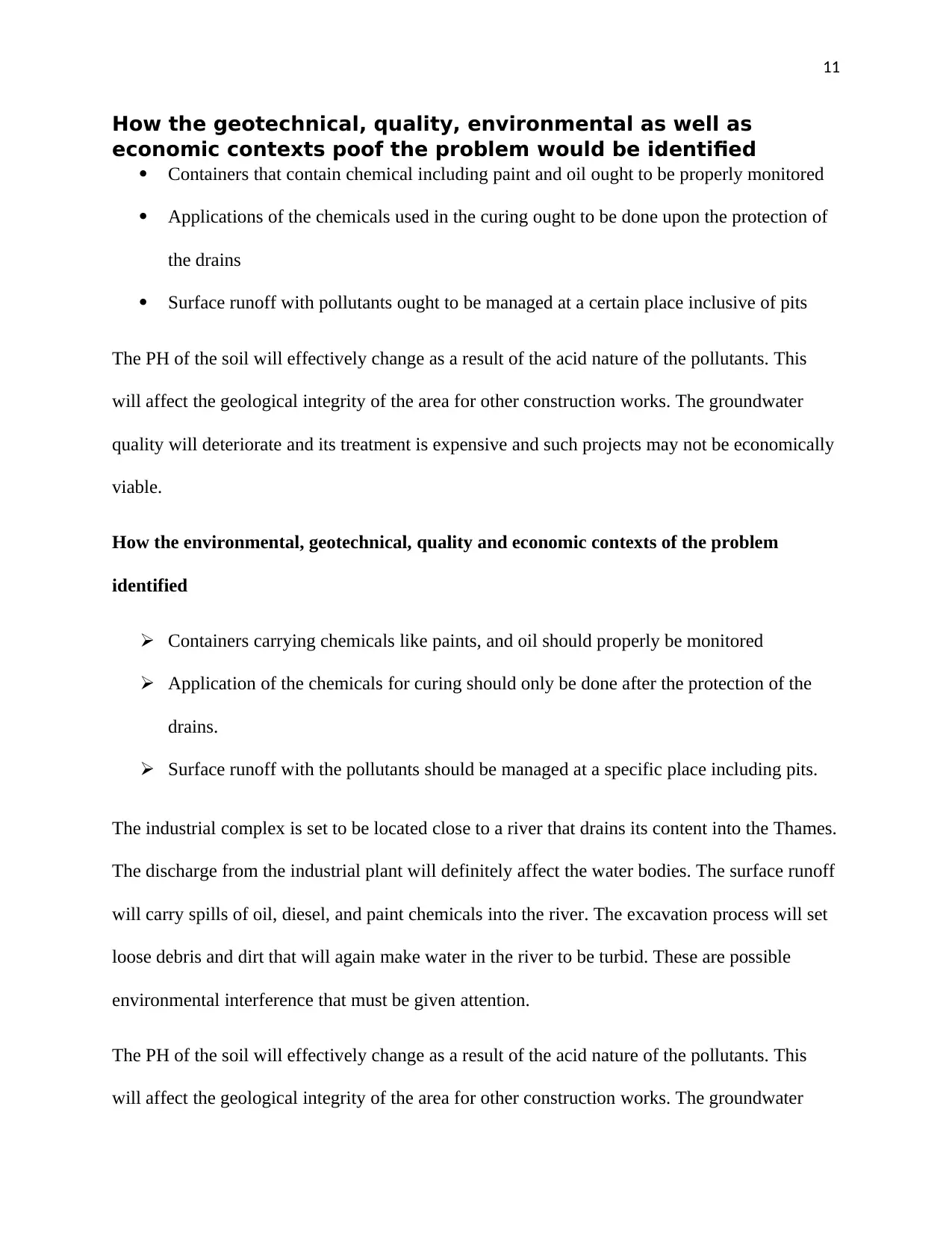
11
How the geotechnical, quality, environmental as well as
economic contexts poof the problem would be identified
Containers that contain chemical including paint and oil ought to be properly monitored
Applications of the chemicals used in the curing ought to be done upon the protection of
the drains
Surface runoff with pollutants ought to be managed at a certain place inclusive of pits
The PH of the soil will effectively change as a result of the acid nature of the pollutants. This
will affect the geological integrity of the area for other construction works. The groundwater
quality will deteriorate and its treatment is expensive and such projects may not be economically
viable.
How the environmental, geotechnical, quality and economic contexts of the problem
identified
Containers carrying chemicals like paints, and oil should properly be monitored
Application of the chemicals for curing should only be done after the protection of the
drains.
Surface runoff with the pollutants should be managed at a specific place including pits.
The industrial complex is set to be located close to a river that drains its content into the Thames.
The discharge from the industrial plant will definitely affect the water bodies. The surface runoff
will carry spills of oil, diesel, and paint chemicals into the river. The excavation process will set
loose debris and dirt that will again make water in the river to be turbid. These are possible
environmental interference that must be given attention.
The PH of the soil will effectively change as a result of the acid nature of the pollutants. This
will affect the geological integrity of the area for other construction works. The groundwater
How the geotechnical, quality, environmental as well as
economic contexts poof the problem would be identified
Containers that contain chemical including paint and oil ought to be properly monitored
Applications of the chemicals used in the curing ought to be done upon the protection of
the drains
Surface runoff with pollutants ought to be managed at a certain place inclusive of pits
The PH of the soil will effectively change as a result of the acid nature of the pollutants. This
will affect the geological integrity of the area for other construction works. The groundwater
quality will deteriorate and its treatment is expensive and such projects may not be economically
viable.
How the environmental, geotechnical, quality and economic contexts of the problem
identified
Containers carrying chemicals like paints, and oil should properly be monitored
Application of the chemicals for curing should only be done after the protection of the
drains.
Surface runoff with the pollutants should be managed at a specific place including pits.
The industrial complex is set to be located close to a river that drains its content into the Thames.
The discharge from the industrial plant will definitely affect the water bodies. The surface runoff
will carry spills of oil, diesel, and paint chemicals into the river. The excavation process will set
loose debris and dirt that will again make water in the river to be turbid. These are possible
environmental interference that must be given attention.
The PH of the soil will effectively change as a result of the acid nature of the pollutants. This
will affect the geological integrity of the area for other construction works. The groundwater
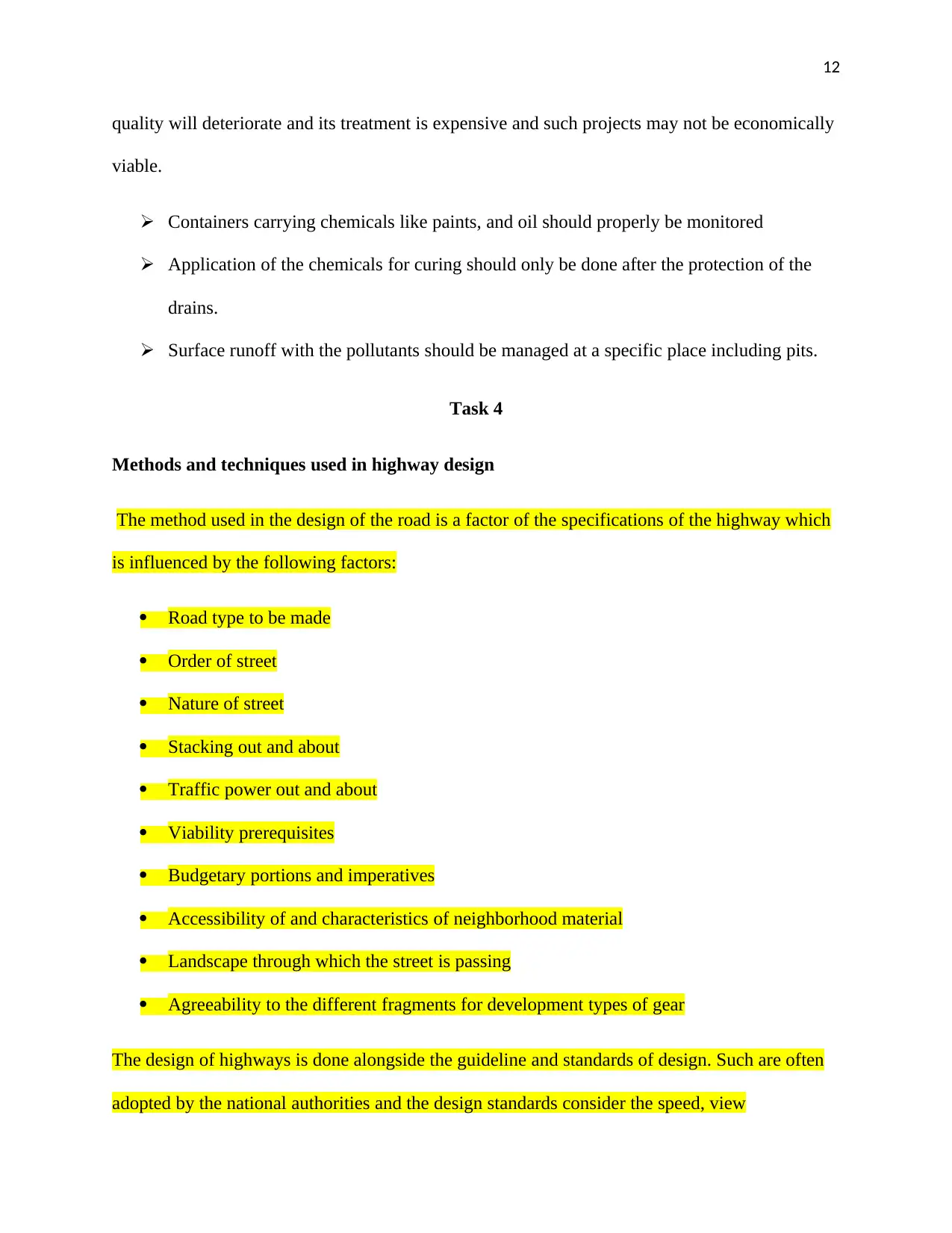
12
quality will deteriorate and its treatment is expensive and such projects may not be economically
viable.
Containers carrying chemicals like paints, and oil should properly be monitored
Application of the chemicals for curing should only be done after the protection of the
drains.
Surface runoff with the pollutants should be managed at a specific place including pits.
Task 4
Methods and techniques used in highway design
The method used in the design of the road is a factor of the specifications of the highway which
is influenced by the following factors:
Road type to be made
Order of street
Nature of street
Stacking out and about
Traffic power out and about
Viability prerequisites
Budgetary portions and imperatives
Accessibility of and characteristics of neighborhood material
Landscape through which the street is passing
Agreeability to the different fragments for development types of gear
The design of highways is done alongside the guideline and standards of design. Such are often
adopted by the national authorities and the design standards consider the speed, view
quality will deteriorate and its treatment is expensive and such projects may not be economically
viable.
Containers carrying chemicals like paints, and oil should properly be monitored
Application of the chemicals for curing should only be done after the protection of the
drains.
Surface runoff with the pollutants should be managed at a specific place including pits.
Task 4
Methods and techniques used in highway design
The method used in the design of the road is a factor of the specifications of the highway which
is influenced by the following factors:
Road type to be made
Order of street
Nature of street
Stacking out and about
Traffic power out and about
Viability prerequisites
Budgetary portions and imperatives
Accessibility of and characteristics of neighborhood material
Landscape through which the street is passing
Agreeability to the different fragments for development types of gear
The design of highways is done alongside the guideline and standards of design. Such are often
adopted by the national authorities and the design standards consider the speed, view
⊘ This is a preview!⊘
Do you want full access?
Subscribe today to unlock all pages.

Trusted by 1+ million students worldwide
1 out of 17
Related Documents
Your All-in-One AI-Powered Toolkit for Academic Success.
+13062052269
info@desklib.com
Available 24*7 on WhatsApp / Email
![[object Object]](/_next/static/media/star-bottom.7253800d.svg)
Unlock your academic potential
Copyright © 2020–2025 A2Z Services. All Rights Reserved. Developed and managed by ZUCOL.




